
Newsletter of the Shell Club of Sydney
NSW Branch, The Malacological Society of Australasia Limited ACN 067 894 848
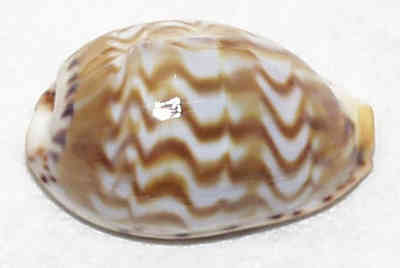
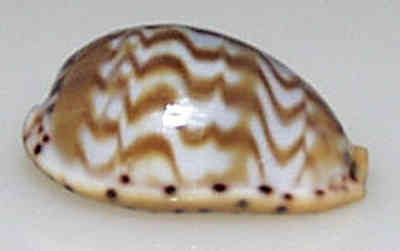
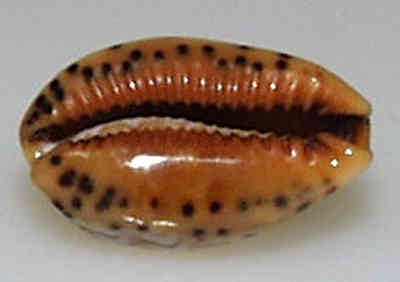
Cypraea ziczac Linnaeus, 1758
Collected, Sydney, NSW Chris Barnes
Cypraeidae of Little Bay
By Chris and Karen Barnes
The first shell I ever collected was a very fine fresh dead large specimen of
Cypraea erosa Linnaeus, 1758. Karen had surprised me with a weekend away for my birthday (Feb 1994) at "Kim's" resort, Toowoon Bay on the central coast. Whilst glancing through a coffee table book I stumbled across an article on shells. The article recommended carefully turning stones at low tide to observe interesting molluscs, so I did and of course still do when I get the opportunity.
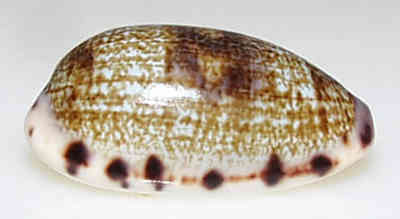
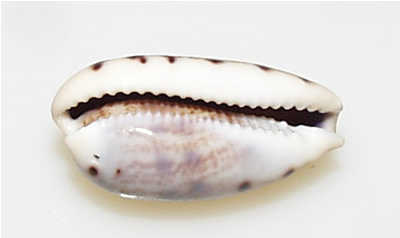
Cypraea caurica

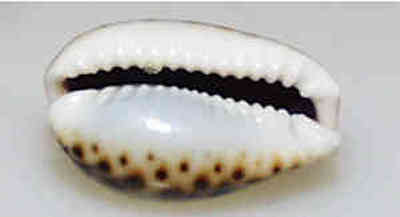
Cypraea flaveola
The first book I ever purchased on the subject of shells was "What Shell Is That" by Neville Coleman, and I still refer to it today. The second shell book I bought was "A Collector's Guide To Sea Shells Of The World" by Jerome M. Eisenberg. The book contains a listing of Malacological Societies of the world. Karen investigated further and through this process we made contact with Michael Keats and the NSW Branch of The MSA. It does not seem like very
long ago (six years this month) that Karen and I were welcomed as new members and shortly thereafter as office bearers, because they're always in demand.
A number of collectors and authors believe the "Cowries" are "overrated" and "overdone", stating they have vast amounts of material written about them already, hence they're boring. I disagree, the Cypraeidae have fascinated me and I would imagine millions of people around the world since long before recorded history. I believe that the beautiful colours and patterns along with their natural highly polished lustrous finish make them desirable to collectors and novices alike. Some of the most wonderful and interesting things about the Cypraeidae are the living molluscs, with their mantle lobes completely extended enveloping the shell when active, yet wholly withdrawn into the shell if the mollusc is threatened. Often the contrast between mantle colour and shell colour can be extreme. One example,
Cypraea asellus Linnaeus 1758, has a jet black mantle with a white shell, crossed by three broad bands on its dorsum, varying in colour from tan to black.
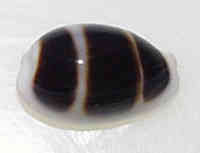
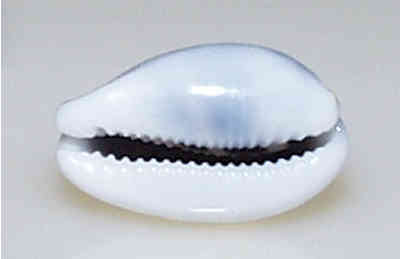
Cypraea asellus
Another example is a specimen of Cypraea teres Gmelin, 1791, which I observed on three separate occasions over a period of one and a half months during visits to Little Bay between 26/12/99 and 06/02/2000. The animal was surprisingly active and yet seemed to stay within a few feet of where it was first observed. Its colour was a translucent, fluorescent orange all over including mantle, siphon and tentacles (plus eye stalks) though its foot was lighter in colour, tending towards white beneath. The papillae were of a medium density on the mantle, their colour was dark green with a yellow/gold dot in the centre (very Australian). The shell had a very light-apricot/cream base, and sides of equal colour with six or seven large dark brown spots. The dorsum was bluish/green with three dark brown widely spaced bands, with many lighter small squiggly lines running the length of the shell. The anterior end callus appears to be a pink/mauve colour. An observation of the location was that the undersides of many of the rocks were covered with various marine growths of an almost identical colour to the cowry. I do not know if the cowry was feeding on these growths or if its colour was an adaptation for camouflage.
For approximately the last eighteen months at various low tides we have made many visits to Little Bay (via Prince Henry Hospital). Over this period we have observed, photographed or collected intertidally twenty- one species of Cypraeidae from this site. I believe the variation of species as far south as Sydney is an interesting point, as many authors consider Sydney beyond the currently accepted range of a number of Cypraeidae. At previous NSW branch meetings the range of various Cypraeidae species was discussed with Stephanie Clark and other experienced shellers. It was indicated that a number of species could be moved down the coast during their veliger stage by the prevailing current. It is believed that these species could survive in the short term, possibly seasonally and not be able to establish or maintain a true breeding population. I can only confirm this view, with my observations, one example is: -
Cypraea arabica Linnaeus, 1758, on the 28/02/1999 we observed three juvenile specimens and obtained some photographs. Over the next few months these cowries were sighted a number of times up until mid way through the year when I believe they could no longer survive the cold weather. I collected their dead shells among rocks, one juvenile on 14/05/99 and one at sub-adult stage on 08/07/99.
The following table contains the Cypraeidae species found over
the last 18 months during visits to Little Bay, Sydney, NSW:
Legend :- A=Alive, D= Dead, FD=Fresh Dead
Number Species Status Occurrence Size
1 Cypraea annulus A seasonally common 29mm
2 Cypraea arabica A seasonal 55mm
3 Cypraea asellus A uncommon 21mm
4 Cypraea caputserpentis A common 43mm
5 Cypraea carneola FD uncommon 71mm
6 Cypraea caurica A uncommon 45mm
7 Cypraea cernica FD rare 20mm
8 Cypraea clandestina A common 19mm
9 Cypraea erosa FD seasonal 41mm
10 Cypraea errones A common 35mm
11 Cypraea felina A uncommon 22mm
12 Cypraea fimbriata A rare 12mm
13 Cypraea flaveola A moderately common 22mm
14 Cypraea gracilis D uncommon 18mm
15 Cypraea humphreysii A rare 13mm
16 Cypraea lynx A rare 15mm
17 Cypraea moneta A seasonally common 29mm
18 Cypraea teres A uncommon 35mm
19 Cypraea vitellus A common 55mm
20 Cypraea xanthodon D uncommon 30mm
21 Cypraea ziczac FD rare 21mm
Some of the more unusual specimens collected and or observed are as follows below.
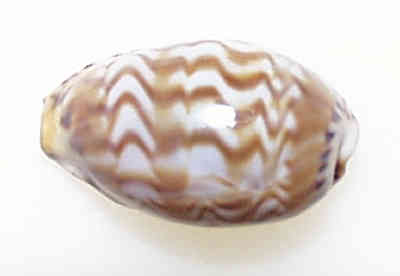
Cypraea ziczac Linnaeus, 1758 collected, Little Bay, Sydney, NSW 14/5/1999 at low tide among rocks (very fresh dead
specimen, see front cover). Barry Wilson in Australian Marine Shells vol 1, 1993 gives the species an Australian range between WA and northern NSW. He also mentions at one time Schilder used the subspecies name
vittata Deshayes, 1831 for east-Aust specimens, and that Iredale (1939) used the subspecies name signata to describe a specimen found at the mouth of the Clarence River northern NSW. He stated that both these names could probably be relegated to synonymy.
Cypraea humphreysii Gray, 1825, I have observed and released two separate examples of this species at Little Bay, both times the specimens were juvenile though on the first occasion Karen was with me so we were able to get some photographs.
Cypraea errones Linnaeus, 1758, Although a common species at Little Bay, the reason I mention it here is that a specimen was found on the 17/11/1998 sitting on a white circular egg mass beneath a medium sized rock. Unfortunately we did not have the camera with us that day, when we returned a couple of days later they were gone.
Cypraea carneola Linnaeus,1758, This species is considered moderately common. What makes it interesting in this case is its size, most authors give a size average of 50mm, and a specimen I collected at Little Bay, on the 10/12/1999 measured 71mm and had been killed by an Octopus.
Cypraea caputserpentis Linnaeus, 1758, I believe this species to be the most common, yet one of the most beautiful. At Little Bay it's obvious the Sydney Octopus
(Octopus cyaneus Gray, 1849) agrees because of the large number of specimens I have seen preyed upon by them. Last weekend whilst shelling at Little Bay, I saw half a dozen octopus in gutters and under ledges yet the one that interested me most was the one with two freshly drilled
C. caputserpentis shells lying outside its den. Between 09/01/2000 and 24/01/2000 I observed two pair of
C. caputserpentis sitting on greyish egg masses, believe it or not under the same rock. The longer the eggs were there the darker and browner they seemed to get and by 06/02/2000 I believe they'd hatched and gone on their way.
I guess since the first shell I collected was a cowry I'm a one eyed supporter and they'll always be my favourites. Its also strangely true that the more I see of these creatures the more interested I become in their conservation and available knowledge. I had read this sentiment in a number of authors' books, and I now believe it to be true.
Shell Club Promotional Flyer
Draft 1 - for discussion, by Michael Keats
Per Information section of these web pages.
New Web Site - The Patella Site
This site is dedicated to the members of the molluscan gastropod family
Patellidae.
http://home.planet.nl/~ftitsela/patella
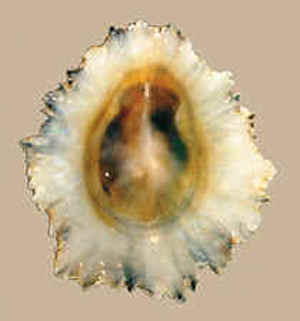
Patella ulyssiponensis Gmelin, 1791 Canary Islands, La Palma, Charco Azul.

A tasty meal of limpets in garlic, Madeira, Caniçal.

While it is still growing it contains some humorous information and a good amount of explanatory information about Patellidae classification and about how specimens live and survive. There is also a place to join add your name to a Patellidae specific on-line club. The site advertises Vita Marina and the pictures on the web pages (Some shown here) come from Vita Marina.
The site opens by categorizing groups of people who have an interest in Patellidae as follows:
Collectors
Among collectors the family is known by the colourful, iridescent inner-side of the shell. The colours and patterns are only to be guessed while looking at the corroded, algae and barnacle covered outer sides. As a rule collectors do not need an eagle's eye to collect limpets. The animals are clinging, often with thousands of individuals, to the stones and the rocks, where they are easily collected at low tide. And also the cleaning of the shells does not require a special technique: after a short period of boiling, the animals come loose, and the inner side can be observed. For many collectors this is the starting poin t of difficulties: the identification and finding the right name.
'Connoisseurs'
The second group, consisting of connoisseurs, can't be bothered by that: they prepare the animal in olive oil. Richly covered by garlic the snails end up on a well-provided table. The animals are also eaten raw during lunch at the coast. On the Azores, Madeira and the Canary Islands, collectors will need an eagle's eye for that reason. On places easily accessible the patellids are decimated.
Biologists and ecologists
This latter phenomenon is a source of research for another group, consisting of biologists and ecologists, who carry out research to the state of affairs concerning the populations and effects of mass collecting and pollution.
Taxonomists
For many years, taxonomists have tried to map the European Patellidae. The research is often focussed on morphological characteristics, like the shape of the shell, radula, and genitalia (Fischer-Piette, 1935). For the last few years, more attention has been given to the biological aspects. Genetic and electrophoretic research tries to reveal the relations between species. Only few papers have been published which make an effort to integrate morphological and biological characteristics (Corte-Real, Hawkins & Thorpe, 1996).
On other pages in the site there is more serious information about Patellids, for example:
Habitat
Rocks wooden piles and larger stones are suitable habitats for these grazers, which live on algae. The surface of rocks can be varied: from flat and smooth to capricious and rough.
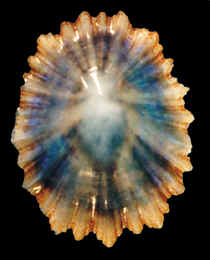
Patella tenuis crenata d'Orbigny, 1840 from Canary Islands, La Palma, Los Cancajos.
Patellids live in the littoral and infralittoral zone and prefer shallow water down to six meters. …. The Patellidae feed on algae, where they work their way through the algae layer rasping with their radula in a zig-zag like way. … The animals cover distances of about one and a half meters. Often the animals return to their original resting place. The mechanism by which a limpet returns to its home commonly involves the chemoreceptive retracing of a mucous trail laid by the animal on its outward journey. Homing behaviour is not observed with every individual.
To prevent dehydration the animal depends on its powerful foot, with which it fixes itself to the rocky surface during low tide. The tension required also pulls the mantle, which causes it to change position. As the mantle is responsible for growth of the shell, conical forms arise in specimens living higher in the tidal zone, and more flattened forms with patellids who live lower in this area (Powell, 1973). The patellids living higher in the tidal zone try to lose superfluous heat by increasing their surface. For that they use the many ribs and ridges on the shell. Patellids with a smooth surface live in an environment amidst waves and streaming water. In this, often turbulent, environment high conical shells are not advisable. A more streamlined shape causes less turbulence. Yet the shells do not necessarily need to be smooth all over: research has shown that fine, upright ribs can minimize turbulence (Orton & Southward, 1961; Fretter & Graham, 1994).
Individuals belonging to one species can differ considerably with regards to their environment. This is one of the reasons why shell characteristics cannot be used as a decisive criterion in identification (see: Ecophenotypical variation).
Conus anemone
At Shark Island
By Michael Keats
Over the last 5 years I have visited Shark Island (Sydney Harbour) on many occasions in the course of monitoring the mollusc fauna.
On visits which were bucketing with rain I used to walk around the island looking hopefully for a change in the weather but also for photo opportunities.
One of the more fascinating finds is the art deco architecture of some old shelter sheds and toilet blocks. A number of these buildings have been faced with cement render into which has been pressed shells. Given the species used, these were presumably collected from the beaches around the island. Over the years the shells have weathered and bleached and vandals and / or souvenir hunters have left many broken.
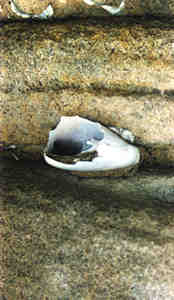
Sufficient fragments remain however, of some specimens to easily identify them. A case in point is
Conus anemone.
(Picture on right taken 29th June 1999) There are at least 3 specimens in the various shell collages on buildings around the island.
Today in the beach drift and grit it is still possible to pick up fragments of this species, some of similar size to the impressed specimens (some are 70 mm+). I have searched in vain for a complete fresh dead specimen. Diving around the island has also failed to locate any live specimens. They are undoubtedly still about but very reclusive!
One can hope that the NSW National Parks and Wildlife Service will not destroy these quaint old buildings, which can still tell the visitor about some of the past of this island.
|















